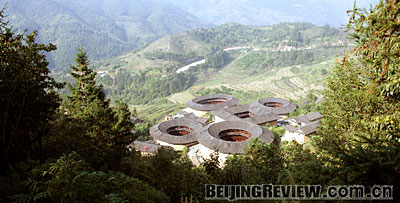|

MOUNTAIN HOME: Tianluokeng Tulou Cluster in Fujian Province consists of five tulous
(Photo by WANG XIANG)
It all started with a mistake that brought Fujian Province's peculiar earthen Tulou houses to the world's attention. In the 1960s, the U.S. intelligence agency found round structures that resembled a nuclear facility hidden in the mountains. On further inspection the buildings turned out to be ancient residential compounds bustling with family life.
The Fujian Tulou is a unique rammed earth structure made by the Hakka and other peoples in the mountainous areas of southeast China. In July 2008, 46 Fujian Tulou sites were inscribed by UNESCO as World Heritage Sites.
"I just knew our Tulou would sooner or later be included into the World Heritage List, but when the good news finally came, I was still full of excitement," said Zeng Wuyue, 76, a pioneer researcher of Tulou architecture.
The international organization described Tulou as, "exceptional examples of a building tradition and function exemplifying a particular type of communal living and defensive organization."
Building formation
Tulou is a particular type of Chinese vernacular architecture. Its layout follows the Chinese dwelling tradition of "closed outside, open inside"--an enclosure wall with living quarters around the peripheral and a common courtyard at the center.
It is common to have a small building at the center with an open front that serves as an ancestral hall for worship, festivals, meetings, weddings, funerals and other ceremonial functions.
The shape of Tulou can be diverse. Besides the dominant circle structure, they also come in semicircles, ovals, squares, rectangles and irregular pentagons.
"The circular shape is a basic concept that primitive people think of as space," Zeng said, explaining why most Tulous are circular. Archeological studies have shown that in this region of China circles represented the god of procreation.
Compared with square structures, circular Tulous are superior in many ways, according to Zeng. "In terms of saving construction materials, light and seismic resistance, circular Tulous are better than square ones," he said.
The foundation of a Tulou is built with paved stones on top of compacted earth in two to three tiers. There is a circular drain around the top tier foundation to prevent rainwater from damaging the Tulou wall.
The buildings are made of earth, stone, bamboo and wood, all readily available materials. After constructing the walls with rammed earth, branches, strips of wood and bamboo chips are laid in the wall as "bones" to reinforce it.
"We feel warm living inside a Tulou as the thick walls keep the wind from blowing into the enclosed space," said Huang Nanbin, 34, who was born and lives in He Chang Tulou, one of the five Tulous that form the renowned Tianluokeng Tulou Cluster in Nanjing County.
Born equal
Unlike much architecture, which reflects social hierarchy, in Fujian Tulou everyone is equal. Usually the ground floor is the kitchen, the second floor serves as a storeroom and the third and upper floors are bedrooms. All the rooms of a Tulou are built the same size with the same grade of material and exterior decoration, so nobody appears privileged, said Zeng.
Each Tulou usually houses one large family clan of several generations, although large Tulou can house more.
All branches of a family clan share a single roof, symbolizing unity and protection under the clan. The central ancestral hall is surrounded by the family households, symbolizing worship of ancestry and solidarity.
As the size of the family expands, the building expands with it, by adding outer concentric rings or building new Tulou nearby to form a cluster. Thus a family clan can stay together.
According to Zeng, many facilities such as wells, a ceremonial hall and food-processing equipment are shared property. Even the surrounding land and fruit trees are shared.
Unsure origins
Over 20,000 Tulou houses still stand today, mostly scattered in the mountainous southeast region of Fujian, including the three counties of Nanjing, Yongding and Hua'an.
It's generally said that the Hakka people (a subgroup of the Han Chinese) created Tulou, but the origin of these unique structures still remains controversial. Some researchers, like Zeng, believe Tulou originated from Zhangzhou, which is dominated by the Minnan people.
Zeng believes people in Zhangzhou first built Tulou during the Ming Dynasty (1368-1644) to guard against assaults by pirates.
"At that time pirates invaded from sea to the land along the Jiulongjiang River. Soldiers were unable to protect the civilians, so they built Tulou to guard themselves," Zeng said. The first Tulous were imitations of coastal defense forts, which were constructed by the government.
The Tulou builders also borrowed inspiration from the mountain blockade. "There's a consistency in the evolution from mountain blockade to Tulou," said Huang Hanmin, a Tulou expert and head of Fujian Architecture Design Institute, said in his book Into the World of Round Tulou. | 